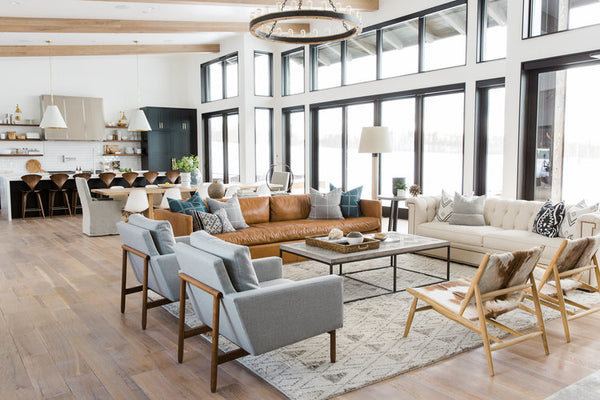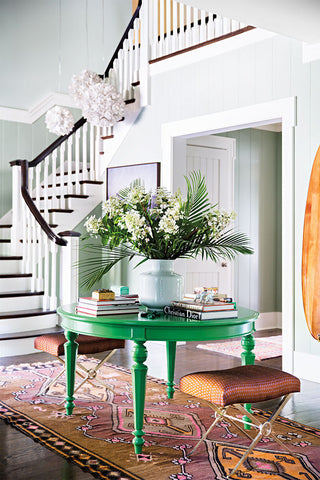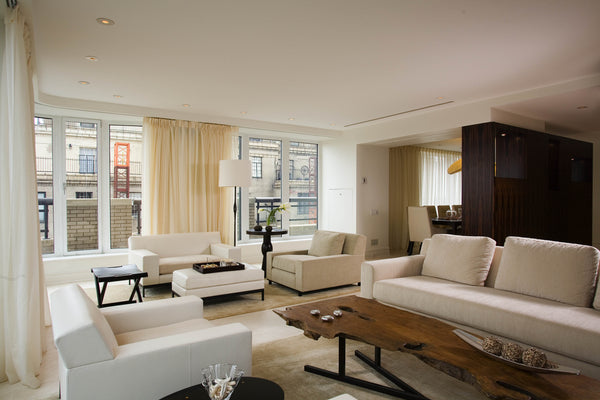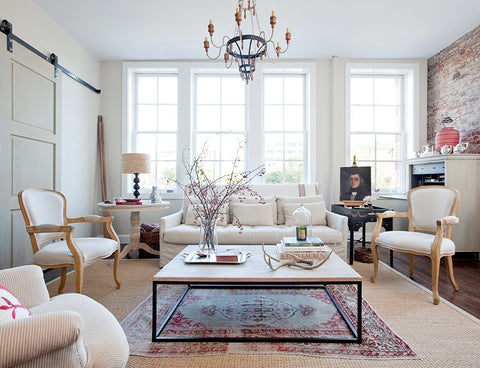When we think about defining a space, we often think about using furniture, shelves or screens. We typically focus on the vertical plane by looking for height to break up the space at eye level and help create zones. Rather than opting for a room divider, switching the mindset to consider the horizontal plane can be an effective way to define your space, particularly an open plan.

Source: www.studio-mcgee.com , Photographer: Travis J Photography
How to use rugs to define a space
Rugs offer more than just comfort and visual appeal. Decorate with them wisely and rugs can help delineate one space from the other. They can be used to separate a living area from the dining room in an open plan interior. Rugs can be used to visual distinguish a study area in a bedroom or a foyer space in a large hallway without the need for a traditional room divider.
It’s not just the open plan spaces that can benefit from a considered arrangement of rugs. Smaller spaces that lack the room for additional furniture will be more liveable and visually appealing without room dividers and screens that will close in on the space. Rugs are also beneficial in rooms which need to perform several functions such as a guest bedroom which also works as an office or a kid’s room that needs to allow for play.
Here we share our tips on how you can create an illusion of containment in your interior without the need for additional walls or room dividers.
Consider the size

Source: homedeco.nl
The size of your rug is one of the most crucial elements to think about when choosing a rug to define your space. Consider where you want your space to end and another one to start. Your rug shouldn’t extend beyond this point and at the very least, sit within one foot of the room’s edge.
Make sure the size of your rug suits the furniture you need to position on the rug. In a dining space for example, the rug should be big enough for your chairs to remain on the rug when they’re pulled out.
Regardless of whether your room is contained by four walls or it’s an open plan, getting the size right is essential.
Tip: get your masking tape out and measure the ideal size before you go rug shopping. It will help you visual the rug which can often be more helpful than getting the measurements.
Play with the shape

Source: Domino.com , Photographer: Brittany Ambridge
Rectangular rugs are one of the most common shapes to use, however they’re not the only shape available. Consider what’s better suited to the architecture of your space. Could a round rug be a better way to delineate a play area in your kid’s bedroom? If your wanting to lay down two rugs in the one open plan space, does the spaces’ layout dictate the shape of the rugs? For example, a square and a rectangular rug may work better than two rectangles.
Also consider the furniture that will sit on the rug and the composition you’re wanting to create. A lounge room setting may look better configured on an intimate square rug over a large rectangular. A round rug may work better under a round dining table or a runner in a foyer.
Be playful and brave with your rug shape rather than sticking to the most common shape available.
Tip: if you can’t find the exact right shape or dimension of rug, consider purchasing a carpet which can be cut to the right size.
Remain cohesive with your colour

Source: www.homeunltd.com
To create a harmonious interior, you need to take the time to consider the colour and pattern of your rugs. One of the simplest ways to create cohesion in an open plan room is by using matching rugs. While it might seem a little safe, using a bold print can work well to create a feeling of repetition without being too bland.
Choosing a rug with similar tones but of a different material can also work to ensure harmony. You may wish to choose a rug with more a textured pile to add warmth and comfort in a living room, and opt for a flat, hardwearing rug under you dining table. If they’re of a similar colour palette, they’ll work to delineate the spaces cohesively.
Working with two or more different patterns can be tricky in the one space. However, combining a solid rug with a patterned carpet can be a much easier task. Choose colours that work well with each other, whether that’s two from the same colour family or a neutral colour that works with anything. They’re less likely to clash and fight with each other if they share a common colour palette and sensibility.
Oriental rugs are an exception to this as they’re ideal to combine in the one space. This is because they’re usually of similar colour tones or patterns. If you’re combining a couple of oriental rugs, choose ones with the same dominant colour to create a cohesive look.
Tip: use rugs to add depth and character to your space by taking in account your room’s colour scheme and the tones in your furniture.
Layer it up

Source: www.elementsofstyleblog.com
Layering rugs on top of each other has become a big interior trend over the last couple of years as it’s a great way to add more texture to your space. The key is choosing patterns and colours that complement, but are still different. For example, a collection of Kilim rugs can work perfectly together as they’re usually of similar colour tones. A cowhide layered over a jute rug helps add visual interest and remains cohesive through the neutral colours.
Layering rugs can be a great way to use your favourite smaller rug in a large space. If the dimension of your favourite oriental rug doesn’t suit your new dining room perfectly, simply put it on top of a larger, neutral carpet to extend its reach. Alternately, layer a collection of smaller rugs to create one large-sized rug.
If you have carpet, layering a rug on top is another effective way rugs can be used to define a space. The look can easily be kept harmonious by picking up a colour in the carpet weave. It’s also just as easy to be bold as most carpet is a neutral colour that works with almost anything!
Tip: if you are going to play with layering, take in account our tips on size, shape and colour to avoid it looking like on big hot mess!
